The ASUS X99-E-10G WS Motherboard Review: 10GBase-T Networking with Intel’s X550-AT2
by Ian Cutress on November 7, 2016 9:00 AM EST- Posted in
- Motherboards
- Intel
- Asus
- 10G Ethernet
- X99
- 10GBase-T
- X99-E-10G WS
- X550
- X550-AT2
System Performance
Not all motherboards are created equal. On the face of it, they should all perform the same and differ only in the functionality they provide - however this is not the case. The obvious pointers are power consumption, but also the ability for the manufacturer to optimize USB speed, audio quality (based on audio codec), POST time and latency. This can come down to manufacturing process and prowess, so these are tested.
Power Consumption
Power consumption was tested on the system while in a single MSI GTX 770 Lightning GPU configuration with a wall meter connected to the OCZ 1250W power supply. This power supply is Gold rated, and as I am in the UK on a 230-240 V supply, leads to ~75% efficiency > 50W, and 90%+ efficiency at 250W, suitable for both idle and multi-GPU loading. This method of power reading allows us to compare the power management of the UEFI and the board to supply components with power under load, and includes typical PSU losses due to efficiency. These are the real world values that consumers may expect from a typical system (minus the monitor) using this motherboard.
While this method for power measurement may not be ideal, and you feel these numbers are not representative due to the high wattage power supply being used (we use the same PSU to remain consistent over a series of reviews, and the fact that some boards on our test bed get tested with three or four high powered GPUs), the important point to take away is the relationship between the numbers. These boards are all under the same conditions, and thus the differences between them should be easy to spot.
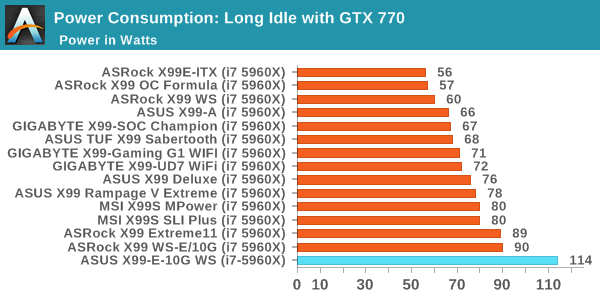

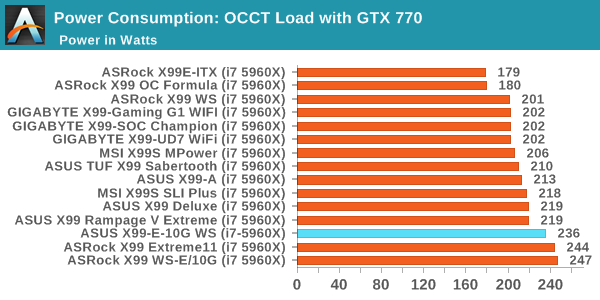
As was perhaps expected, the motherboards with the mode controllers end up drawing the most power. At idle and long idle, the X99-E-10G (at the wall) seems to consume a good portion of power, but during load the other big controller boards seem to draw more, making the CPU efficiency of the ASUS board quite good.
Non-UEFI POST Time
Different motherboards have different POST sequences before an operating system is initialized. A lot of this is dependent on the board itself, and POST boot time is determined by the controllers on board (and the sequence of how those extras are organized). As part of our testing, we look at the POST Boot Time using a stopwatch. This is the time from pressing the ON button on the computer to when Windows 7 starts loading. (We discount Windows loading as it is highly variable given Windows specific features.)

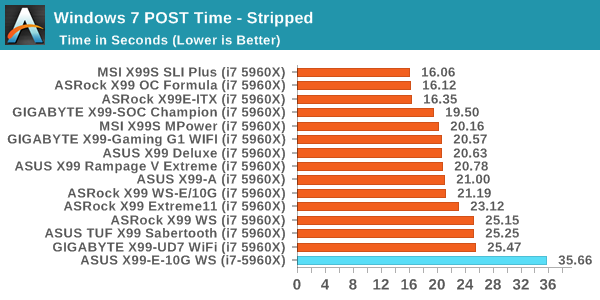
With extra controllers comes extra POST time, so moving nearer 50 seconds for a stock POST is not unexpected.
Rightmark Audio Analyzer 6.2.5
Rightmark:AA indicates how well the sound system is built and isolated from electrical interference (either internally or externally). For this test we connect the Line Out to the Line In using a short six inch 3.5mm to 3.5mm high-quality jack, turn the OS speaker volume to 100%, and run the Rightmark default test suite at 192 kHz, 24-bit. The OS is tuned to 192 kHz/24-bit input and output, and the Line-In volume is adjusted until we have the best RMAA value in the mini-pretest. We look specifically at the Dynamic Range of the audio codec used on board, as well as the Total Harmonic Distortion + Noise.
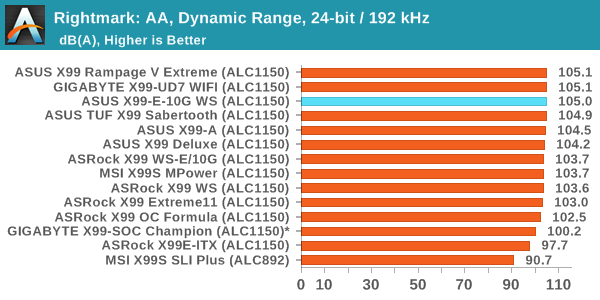
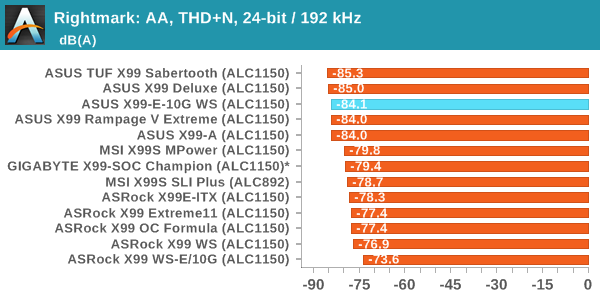
Despite audio not being a primary feature of the X99-E-10G WS, the performance (as with most ASUS boards) is in the top half of our testing and right ner the top. The fact that ASUS holds the top five spots in our X99 THD+N testing is rather impressive.
USB Backup
For this benchmark, we transfer a set size of files from the SSD to the USB drive using DiskBench, which monitors the time taken to transfer. The files transferred are a 1.52 GB set of 2867 files across 320 folders – 95% of these files are small typical website files, and the rest (90% of the size) are small 30 second HD videos. In an update to pre-Z87 testing, we also run MaxCPU to load up one of the threads during the test which improves general performance up to 15% by causing all the internal pathways to run at full speed.
Due to the introduction of USB 3.1, as of June 2015 we are adjusting our test to use a dual mSATA USB 3.1 Type-C device which should be capable of saturating both USB 3.0 and USB 3.1 connections. We still use the same data set as before, but now use the new device. Results are shown as seconds taken to complete the data transfer.
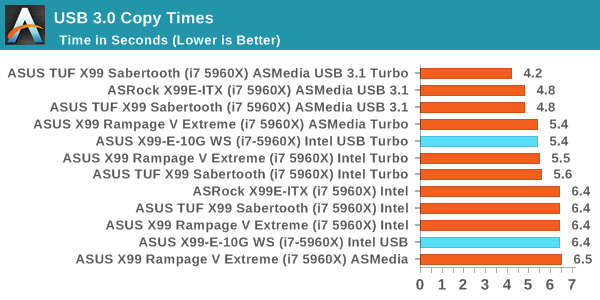

DPC Latency
Deferred Procedure Call latency is a way in which Windows handles interrupt servicing. In order to wait for a processor to acknowledge the request, the system will queue all interrupt requests by priority. Critical interrupts will be handled as soon as possible, whereas lesser priority requests such as audio will be further down the line. If the audio device requires data, it will have to wait until the request is processed before the buffer is filled.
If the device drivers of higher priority components in a system are poorly implemented, this can cause delays in request scheduling and process time. This can lead to an empty audio buffer and characteristic audible pauses, pops and clicks. The DPC latency checker measures how much time is taken processing DPCs from driver invocation. The lower the value will result in better audio transfer at smaller buffer sizes. Results are measured in microseconds.
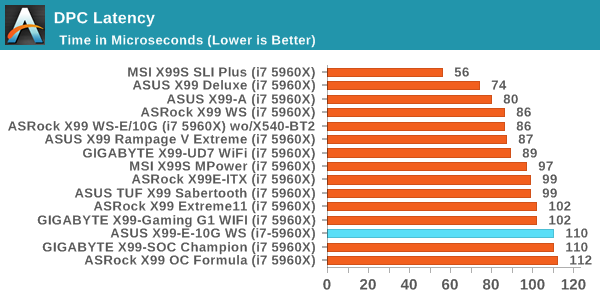
While a result of 110 is not the best X99 result, given the recent set of 250 microsecond results we've been seeing on the 100-series board, anything below that is pretty good.










63 Comments
View All Comments
dsumanik - Monday, November 7, 2016 - link
Agreed, but there is a lot of PCI lane juggling on this board as is. With the amount of modern external and internal interfaces being pushed currently the days of 'one board to do it all' may be gone forever, sadly.Ultimately this board is going to appeal to users who want to use PCI Slots taken up by 10g rider cards in thier current rigs.
IMO the idle power is a bit of a concern, over the life of the board it is going to add up, especially if used for server duties.
Notmyusualid - Friday, December 2, 2016 - link
Yes I noticed that too - hence I just picked up a new ASRock ws-e/10G which has the Thunderbolt header (TB2 I think it is - but that is fine with me). But what I didn't expect, was that I'd need to BUY the pcie card to actually present the interface. I must admit, I expected something like that to be in the box. More expense.Just waiting for my E5-2690v4 Broadwell-EP 14-Core 135W 35M CPU to clear customs to check it all out...
sorten - Monday, November 7, 2016 - link
what is the use case for 10G in the home?jkhoward - Monday, November 7, 2016 - link
People who render using multiple workstations want a super fast network. You can chain multiple systems together to render something faster. Think... home graphic designed/video editor.timbotim - Monday, November 7, 2016 - link
My primary use case is 30sec transfer of VMs around a network at 10Gbs-1 rather than 5mins at 1Gbs-1beginner99 - Tuesday, November 8, 2016 - link
Thats a niche use case and you will need a PCIe SSD to write that much data in such a short time. A 20 GB VM would require a write speed of about 680Mb/s.sorten - Monday, November 7, 2016 - link
I see, so the average consumer running a render farm in their home office ;-)philehidiot - Tuesday, November 8, 2016 - link
Personally, I tend to render farts in my home office.I do not require quite so many PCIe lanes for this.
slyphnier - Wednesday, November 9, 2016 - link
that not cost efficient for home graphic designer/video editor, because u end up spend like more than $15k(depends on many ws) for multiple ws including the switch/router... even say your system/rig will last you like 3-4 years, that will be much cheaper go with rental rendering server/office routei believe this board is limited, with shop that have this & available quantity
Notmyusualid - Friday, December 2, 2016 - link
They ARE limited, I cannot find waterblocks for mine... But, I can live with that.At least having your own hardware, its a KNOWN cost, and some provider doesn't contact you to notify you that you own $7k usd this month in network over-usage due to some redirection error you made...